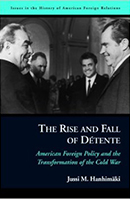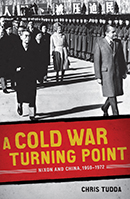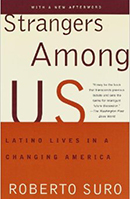Children of Barrios: Tales of Fading Hope
By Hamdy Masri

Roberto Suro
Roberto Suro was born to immigrant parents in a Puerto Rican barrio in New York. He began his journalistic career in 1974 when he wrote for the Chicago Sun Times; other journals Suro wrote for include the Chicago Tribune, Time Magazine, New York Times, and The Washington Post. He is a professor at USC, and headed many immigration research organizations.





“Latino immigration delivers short-term gains and has long-term costs.”1 This quote, from Roberto Suro’s work Strangers Among Us: How Latino Immigration Is Transforming America, accurately displays Suro’s take on Latin immigration to the United States, and is the repeating tone of his work. Although the purpose of this essay was to reflect on a book relating to the 1970’s, Strangers Among Us reflects on Latino immigration as a whole; therefore, most of this report will reflect on that, Latino immigration as a whole and not just the particular time period. However, the later parts of this report will reflect on the decade in question and will emphasize the change in Latino immigration that occurred during the 1970s. The author, Roberto Suro is the son of Latino immigrants himself, has obvious bias for immigrants, and this is reflected in his work. Many book reviewers analyzed this tendency as well. However, the author accurately portrays immigrant life despite his bias, and makes accurate predictions for the future.
The author begins the book with the story of 15 year old Imelda. Imelda is the daughter of Mexican immigrants, and is celebrating the traditional coming of age party for Mexican daughters. The opening gives the book a gleeful, pleasant tone, but it soon makes an abrupt change when the next day Imelda reveals to her parents that she is pregnant, dropping out of school, and moving away with her boyfriend. Suro later describes her as a “dime-store Madonna”.2 Dismal accounts such as this are spread throughout the book, each with the repeating characteristic of a sense of early optimism and ending with sad truths. Suro titles the first part of his four part book: They Are Here. He uses this section of the book to describe the process of how Mexican immigration “Gained momentum after the 1960’s and then turned into something huge in the 1980’s.”3 Early on, he describes Imelda’s tale and that most Latino immigrants choose to isolate themselves not only from other races, but from Mexican-Americans as well. The author describes various push and pull factors of Latino immigration stating, “Politics forced them to go. Their pocketbooks drove them. They had family and friends in the United States who pulled at them.”4 Suro closes the section with the account of Juan L. Chanax, a Guatemalan Mayan immigrant who was the first of his people to come to America and ended up creating a route that would bring two thousand Guatemalan Mayans in the next fifteen years.
Having finished stating the thesis and general ideas of his work, Suro continues to the next part of his book, which he titled: Challenging the Host, to introduce different conflicts and issues regarding illegal immigrants. He opens this section by describing the immigrants in east LA in a peculiar way, calling them Day people and Night people. He describes the Day people as newer immigrants who go out during the day to find work. Night people are on the other side of that coin: they are older, second generation immigrants, and are affiliated with gangs. The author interviews members of both parties, starting with the Day people. The immigrants he interviewed described different occasions of work they got; they were hired by both good people who understood their pain, and bad people who took advantage of the immigrants’ misfortune. The author then transitions to talk about early immigration in the 19th century. He describes different abuses and discrimination immigrants went through, including lynching. Discriminations like these occurred easily and frequently because the immigrants had no political standpoint. Continuing, the novel accounts a moment when the Reagan administration attempted to make a decision on immigration. After hearing plenty of debate on the issue, the president ended the debates when “he joked, ‘Maybe we should just brand all the babies.’”5 Backtracking, the author explains how immigration first became a serious issue in the 1970s. In 1974, after Watergate, the Arab oil embargo, and “Stagflation”, illegal aliens became a problem for the first time. Immigrants began to take jobs from Americans, and this naturally angered many unemployed people who were suffering because of this. This section ends with the accounts of Barbra Coe from Orange County. Coe started a prop in 1994; prop 187, dubbed the ‘Save our State initiative’, would crack down on illegal immigration and restrict benefits to immigrants in California. The author, having been to their meetings, describes the profound racism with Coe and her followers, but still does them justice in telling their point of view. Prop 187 soon passed.
The work continues to describe the histories and tales of different Latino immigrant groups in America. Building the Barrios is the title Suro chose for this section, the longest in the book. Barrios are sections in cities that are run by immigrants of a certain Latino nation, with each barrio consisting of different nations with different stories and experiences. Barrios are not set neighborhoods with borders however, but more of “a frame of mind and a network of relationships that is interwoven.”6 In this section, the author goes from a variety of major cities, Los Angeles, Houston, New York, and Miami, and describes different histories and cultures in each of their barrios. Each barrio is different in their culture and economies; however, each one has a repeating pattern of high crime and substance abuse rates. All of the barrios reflected its people’s desire of isolation from other races, and often thrived because of this. People in the barrio typically only shop within the barrio and stimulate the economy that way. However, if and when the United States’s economy is not ideal, immigrants are typically the first to be fired, and the barrio’s economy loses its source of stimulation.
Finally, the author closes the book with his last section, Accept the Fear. Suro opens the section with Chicago and its Irish immigrant mayor, Richard J. Daley. Suro described that Chicago was the city that worked “because it was a complete ecosystem, in which every group had its niche. Chicago insisted on order but allowed for conflict among ethnic and racial groups so long as it was managed conflict.”7 The different minorities in the city competed for jobs and kept themselves in check, each competing for the same jobs, and thus keeping pay low. The author then turns the purpose of the section stating that “The following chapters examine some of the events of the 1990’s that have begun to shape the new arrangements that will govern urban America in the next century.”8 The rest of the section describes different conflicts and unities between different immigrant groups; most of these groups have the same patterns and set up conflicts for the future. The author then outlines different recommendations he has towards immigration. Suro ends the book with theoretical inferences as to what the future for Latin American immigration holds, and states that the children of the barrios will have an identity crisis and a painful journey to acceptance.
The opening of this essay describes Suro’s thesis in its most basic form: “Latino Immigration delivers short-term gains and has long-term costs.”1 Suro uses this as the opener for his actual thesis. The United States adapted a deficit policy for Latin immigrants, a form where the immigrant’s hard work and low payments provide them with immediate benefit; however, the immigrants and their children were accepted into American society and thus have had the fate of their future constantly put off. Consequently, immigrant children and society experience the backwater of the United States, and deal with it isolated. Their children’s future is still arriving however, and more immigrants constantly arrive. Therefore, the United States needs a new policy on immigration, and in order to be accepted immigrants who have arrived must turn their backs on coming illegals. This is the author’s prolonged and detailed thesis. He uses the novel to justify his thesis by means of examples, and shows different policies that have worked. He ends it with a call to action to both the United States government and immigrant people, that they must suppress and turn their backs to further immigration.
Roberto Suro is a journalist with more than 40 years of experience, as well as a professor and an author. As of today, he is a professor at the Annenberg School for Communication and Journalism of the University of Southern California. He is also a Latino immigrant; his “father came from Puerto Rico in the 1920’s, [his] mother from Ecuador in the 1940s.”9 His immigrant background gave Suro both personal experience and bias in writing his book. His experience in journalism as well as his background gave him adequate sources, and his education allowed him to complete his task. Strangers Among Us was published in 1998; however, the dates of interviews and complexity of the book allows the reader to infer that the author begun his work earlier in the decade. Suro began his book to discuss the issue that has been put off for second and third generation immigrants in the 21st century.
Latino America, by George J. Borjas, is a critical review of Suro’s Stranger’s Among Us. Borjas, an economics and social policy professor at Harvard, begins his review by summarizing the major points in Suro’s work, stating how Suro’s “account is quite depressing and rings a loud warning bell.”10 Early in his review, Borjas seems to have a positive perspective on Suro’s review; however, he seems to become defensive when discussing Suro’s account of Miami’s Barrio. Borjas’s bias is evident here, and is explained by a full disclosure stating, “The author of this review was born in Cuba and as a young boy lived for two years in Miami’s Cuban enclave during the early 1960s.”11 He ends his review criticizing Suro’s suggestion of detaining immigrants “by putting them in detention for a day or two.”12 Borjas explains that this solution is too costly, and will never work because of it. In the end, Borjas praises Suro’s account for its detail, research, and accounts, but criticizes him for his analysis.
Border Crossers—A journalist’s travels through the Latino United States, by Jonathan Rieder of the New York Times, is a less summative, and more optimistic review of Suro’s work. Instead of accounting the details of Suro’s work like Borjas’s review, Rieder simply states all of Suro’s conclusions. Rieder, a white American, has an unbiased view on Suro’s book. Even so, he tends to focus on the more optimistic points of Suro’s novel, ignoring the dreary conclusions of all of Suro’s tales. Unlike Borjas, Rieder believes Suro analyzed immigration well, believing that “[Suro] knows his social science and deploys it surely.”13 Rieder continues to restate all of Suro’s conclusions with a positive outlook.
Imelda’s transformation from a Mexican daughter who made her parents proud to a “dime store Madonna” sets the echoing tone in Suro’s work.2 His book repeats this pattern of an optimistic start followed by its oxymoronic conclusion. He uses this not only to describe the individual accounts, but also to describe the immigrant story as a whole. His goal in telling separate accounts in the third part of his book Building the Barrios was to show distinction between ethnicities, but this pattern unintentionally unified the different nations in our perspective. Using this positive beginning with negative output system shows both sides of immigration: the hope and the reality. This makes the reader feel pessimistic about immigration and illegal’s story as a whole. Although his accounts were accurate and detailed, the repeating oxymoronic pattern showed pessimistic truths about an illegal’s life.
Although this work is on immigration as a whole, it does contain analysis specifically on the 1970s. The author notes how a time of crisis in the 1970s created troubles for immigrants for the first time. In 1974, after Watergate, the Arab oil embargo, and “Stagflation”, illegal aliens became a problem for the first time.6 The different crisis and the poor economy left many Americans without jobs, and so the unemployed blamed immigrants who were taking their jobs for excessively low wages. The desire to restrict illegal immigration was born in the 1970s. Immigrants had come to the United States centuries before the 1970s; however, the large unemployment caused by ‘Stagflation’ caused the desire for illegal restrictions to begin. All the attempts to reduce the illegal work force and immigration came as an aftermath of realizations in the 1970s.
Never going into excessive detail about different immigration laws in the 60s, Suro still states that illegal immigration “gained momentum after the 1960’s and then turned into something huge in the 1980’s.”3 The seventies were a continuation of the sixties in that illegal movements were gaining momentum and paving different routes for those who would follow them. Like the story of Juan L. Chanax, a Guatemalan Mayan illegal immigrant who was the first of his people to travel to the United States, his journey began in 1978. Word of people who left to the United States and made money had reached Juan in his village, but he had never met anyone who made the trip. As a young man, Juan left his village in 1978 and headed for America. Juan ended up in Houston mopping a supermarket floor; however, Juan was not alone for long. Juan recalls: “First my relatives came… and then my friends came, and then the friends of my relatives and then the relatives of my friends and then the friend of my friends’ relatives came. And now those who remained in Totonicapán [his village] are sending their children.”14
Opening his work with the tale of Imelda and becoming a “dime-store Madonna” sets the depressing tone for the near entirety of the book. Through reading all of the accounts of troubles and tales of injustice, one cannot read this book without wondering if the hardship Illegals go through is really worth it. To flee into such poverty makes one wonder what they are fleeing from, yet there does seem to be hope for the third generation, as stated by Suro: “The United States may not have much use now for Imelda’s son, but... just as the bulk of the baby-boom generation hits retirement age…when the proportion of elderly to young workers is going out of whack, this country will have a great need for him and the other children born in the barrios.”15
Footnotes:
- Suro, Roberto. Strangers Among Us—How Latino Immigration Is Transforming America. New York: Alfred A. Knopf, 1998. 4.
- Suro, Roberto. 5.
- Suro, Roberto. 5.
- Suro, Roberto. 29.
- Suro, Roberto. 90.
- Suro, Roberto. 160.
- Suro, Roberto. 238.
- Suro, Roberto. 242.
- Suro, Roberto. 11.
- Borjas, George J. “Review of Suro Book.” Review of Suro Book. National Review, 18 May 1998. Web. 31 May 2015. 1.
- Borjas, George J. 1.
- Borjas, George J. 2.
- Rieder, Jonathan. “Border Crossers.” The New York Times. The New York Times, 11 Apr. 1998. Web. 31 May 2015. 2.
- Suro, Roberto. Strangers Among Us—How Latino Immigration Is Transforming America. New York: Alfred A. Knopf, 1998. 32.
- Suro, Roberto. 13.




1 - 4
<
>